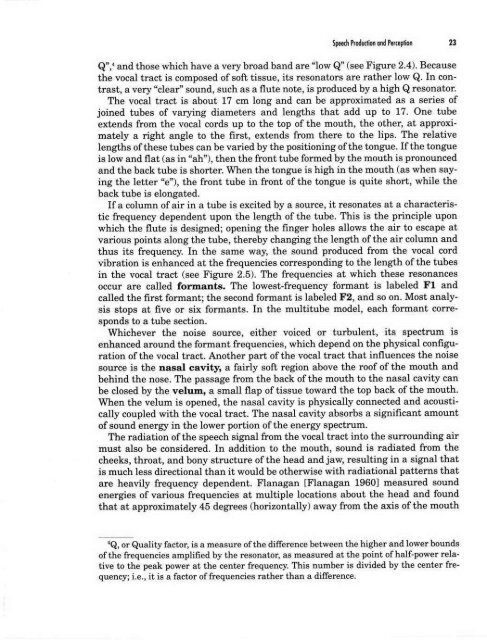MAS.632 Conversational Computer Systems - MIT OpenCourseWare
MAS.632 Conversational Computer Systems - MIT OpenCourseWare
MAS.632 Conversational Computer Systems - MIT OpenCourseWare
Create successful ePaper yourself
Turn your PDF publications into a flip-book with our unique Google optimized e-Paper software.
SpeeProduion nd Perpli<br />
Q",' and those which have a very broad band are "low Q" (see Figure 2.4). Because<br />
the vocal tract is composed of soft tissue, its resonators are rather low Q. In contrast,<br />
a very "clear" sound, such as a flute note, is produced by a high Q resonator.<br />
The vocal tract is about 17 cm long and can be approximated as a series of<br />
joined tubes of varying diameters and lengths that add up to 17. One tube<br />
extends from the vocal cords up to the top of the mouth, the other, at approximately<br />
a right angle to the first, extends from there to the lips. The relative<br />
lengths of these tubes can be varied by the positioning ofthe tongue. If the tongue<br />
is low and flat (as in "ah"), then the front tube formed by the mouth is pronounced<br />
and the back tube is shorter. When the tongue is high in the mouth (as when saying<br />
the letter "e"), the front tube in front of the tongue is quite short, while the<br />
back tube is elongated.<br />
If a column of air in a tube is excited by a source, it resonates at a characteristic<br />
frequency dependent upon the length of the tube. This is the principle upon<br />
which the flute is designed; opening the finger holes allows the air to escape at<br />
various points along the tube, thereby changing the length of the air column and<br />
thus its frequency. In the same way, the sound produced from the vocal cord<br />
vibration is enhanced at the frequencies corresponding to the length of the tubes<br />
in the vocal tract (see Figure 2.5). The frequencies at which these resonances<br />
occur are called formants. The lowest-frequency formant is labeled F1 and<br />
called the first formant; the second formant is labeled F2, and so on. Most analysis<br />
stops at five or six formants. In the multitube model, each formant corresponds<br />
to a tube section.<br />
Whichever the noise source, either voiced or turbulent, its spectrum is<br />
enhanced around the formant frequencies, which depend on the physical configuration<br />
of the vocal tract. Another part of the vocal tract that influences the noise<br />
source is the nasal cavity, a fairly soft region above the roof of the mouth and<br />
behind the nose. The passage from the back of the mouth to the nasal cavity can<br />
be closed by the velum, a small flap of tissue toward the top back of the mouth.<br />
When the velum is opened, the nasal cavity is physically connected and acoustically<br />
coupled with the vocal tract. The nasal cavity absorbs a significant amount<br />
of sound energy in the lower portion of the energy spectrum.<br />
The radiation ofthe speech signal from the vocal tract into the surrounding air<br />
must also be considered. In addition to the mouth, sound is radiated from the<br />
cheeks, throat, and bony structure of the head and jaw, resulting in a signal that<br />
is much less directional than it would be otherwise with radiational patterns that<br />
are heavily frequency dependent. Flanagan [Flanagan 19601 measured sound<br />
energies of various frequencies at multiple locations about the head and found<br />
that at approximately 45 degrees (horizontally) away from the axis of the mouth<br />
4Q, or Quality factor, is a measure of the difference between the higher and lower bounds<br />
of the frequencies amplified by the resonator, as measured at the point of half-power relative<br />
to the peak power at the center frequency. This number is divided by the center frequency;<br />
i.e., it is a factor of frequencies rather than a difference.<br />
23

















